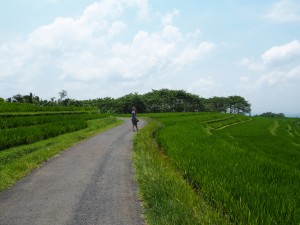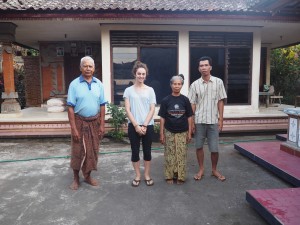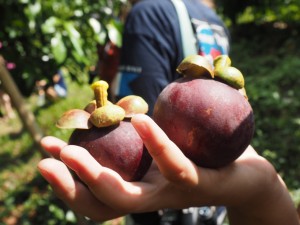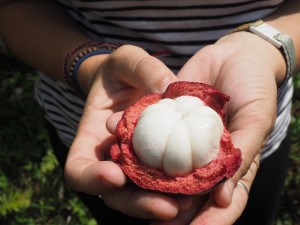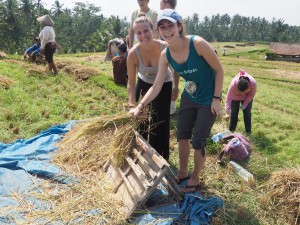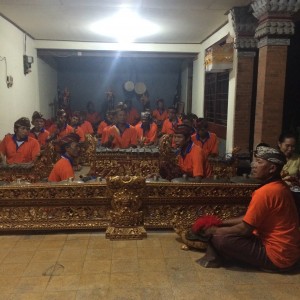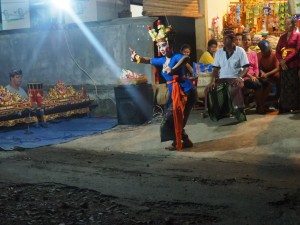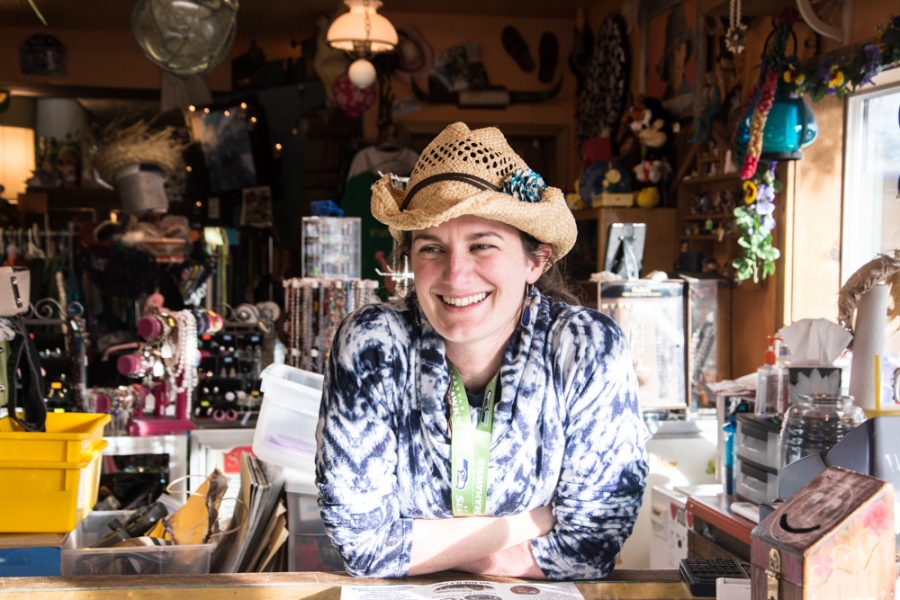We arrived at the village by foot, which was perhaps the most practical way given the amount of potholes in the somewhat-paved road that were not quite catered for a four wheeled vehicle full of college students. In retrospect it also seemed like the most appropriate way to start our short stay in the village, free from cars, free from technology, walking through rice fields without a car window in the way or headphones in my ears. Our walk was incredibly hot and gave many of us a sunburn, but we lots of cocoa trees (which surprisingly tastes really good, once you crack them open and eat the white substance around the seeds) and rice fields which were so beautiful and made it all worth it. Not to mention the two young coconuts I had at the end, which came at about the best time ever.
The village my group visited is called Munduk Pakel, located in the Tabanan district in central-ish Bali. It is the village that my Academic Director is from, and is not frequented by tourists besides an SIT group every semester. This made our visit really special, as Bali is so heavily touristed that it’s hard to go somewhere without seeing any other foreigners. We visited the village for five days – just enough time to begin to get a taste of the life. Many of the residents are farmers, most of rice but also some coconut plantations (and potentially other crops, although I am not positive what kinds).
We invited students from Udayana University (a university in Denpasar), and so in the end we were joined by 14 students, mostly first years as others had exams that week. They all seemed excited to join us and many had never been to rural villages in Bali before. On the last two days they helped us do interviews with locals for our village research paper, so we were able to connect and work together interviewing people. I interviewed five people about the same topic as my research my project (which I will explain in a later post!), but since I did my interviews in Bahasa Indonesia, it was a little bit difficult to understand every response. Still, being sort-of able to do an interview in a foreign language that I’ve only been studying for two months felt like a huge accomplishment!
While in the village I stayed with a sweet host family in their compound. Every meal I had was some variation of noodles and peanuts, sometimes with an egg on the side, and even one time with three little (dead) fish on a plate, staring right at me. I love noodles and peanuts so I was always happy, although I couldn’t bring myself to touch those fish the night they were served on my dinner tray. My favorite part about my homestay was my host-grandfather (Kak in Bahasa Indonesia), who sat with me for nearly every meal and enjoyed asking me tons of questions in Bahasa Indonesia. After five days in the village I think my conversation skills improved tremendously, mostly just from these little chats with him. The rest of the family was also quite friendly, but they kept to themselves more, and I was not around the house that much as we had a lot of activities and downtime was mostly spent at our academic director’s family compound.
Other highlights from the village included:
-Lots of walks through rice fields! As a group we walked through my academic director’s property and nearby rice fields learning about natural medicine, and along the way picked up various plants and fruit that could be used for medicine, food, or offerings. I loved this little walk, and not just because I was able to eat a mangosteen right off the tree (although that was a big reason). We were able to collect enough ingredients to make a sambal (a type of sauce, usually with red chilis but I don’t think there were any in this one) and boreh, which is a medicinal paste made from leaves, cloves, bark and herbs and rubbed on the body to relieve pain. After our walk I helped to make the boreh, which was mostly just a lot of grinding using a mortar and pestle, with the occasional lemongrass or ginger tea break (which I’ll admit I was a bigger fan of than the mortar and pestle work). In the end I tried both the sambal and boreh – the sambal was tasty over rice, a mixture of herbs and onions I think, and the boreh I put all over my shins and feet, and never felt any different. Some people said it was cooling, though, so maybe it was just me.
Fresh mangosteen! This fruit is delicious and one of my favorites.
Our other hike through rice fields was to a Balian, a Balinese traditional healer. This Balian must have been at least 90 years old, but still was able to walk fairly well. He had only two bottom teeth, and wore a coat with huge shoulders – quite the character. He spoke to us briefly about his experiences, describing cases where he helped patients with physical ailments, and then he showed us a rock he found in the river that helps him tell if he is able to help a patient (basically he looks through a little hole and if he can see the person on the other end he is able to help and cure them). He took a few questions from us, but once his incense ran out he stopped talking. Seems like a pretty good excuse to stop, if you asked me.
Our last adventure in a rice field was near the end of our trip, when we walked to a nearby village to help with rice harvesting (side note: walking up and down hills in the hot sun = extreme sweatiness). I don’t know how much of a help we actually were, but it was pretty fun to be in the middle of a huge field of rice paddies and see what the rice looks like before it ends up on my breakfast, lunch, and dinner plates (not a joke – Balinese eat rice three times a day). Our job in the rice paddy was mostly just to take bunches of rice stalks and hit them against this wooden contraption, so the rice kernels would fall off. Some students got really into the process and even helped cut off some of the rice stalks, but I just preferred exploring the rice paddy and hangin’ out with the cows.
-We played gamelan in the village! I’m not sure if I have talked about gamelan in my past posts, but it is a group of instruments played in Bali and Java mostly made up of instruments similar to the xylophone, but there are also some tambourines and drums. We were taught by the local gamelan band in the balai banjar, which is similar to a community center, and after two nights of “lessons” our group was able to play four different melodies. The gamelan men helped us all learn the notes by holding the mallets with us as we hit the keys, but they were fairly simple and repetitive, so it was not too difficult. Occasionally I would zone out, only to look up and realize that one of the old gamelan men would be looking right at me as I played the wrong notes. Whoops. Gamelan is an essential part of many ceremonies here, so we were finally able to play some tunes that we hear all of the time (albeit a bit easier than the common ones). Ironically, as I write this blog post there is a live gamelan troupe playing about twenty feet from me, so I have some nice inspiration.
For our last night in the village, we went to a “block party” like no block party I’d ever seen before. A gamelan band set up in the street, and we were all treated to a Balinese flirtation dance, the joged bumbung (which is really fun to say). There were five different dancers, and they came out one by one. They’d start with a solo dance, complete with the traditional eye movements and super bent hands (that I still am not able to do, even though I’ve tried), and then once the music would change slightly they’d pull out a fan and come towards the audience. Each of us was invited up to dance and “flirt” with the Balinese dancer, and when it came to be my turn I got up there and mostly just awkwardly giggled the whole time.
Like I said before, our few days in the village were the perfect way to see another side of Bali. In the village I felt free of the tourist label, which is nearly impossible to escape here. Before going I was nervous to experience rural life, perhaps because I wasn’t really sure what to expect or because I was convinced that there’d be no running water and we’d have to eat bugs – both rumors that went around. I did not eat any bugs (except for maybe the spider that supposedly everyone eats in their sleep once in awhile) and there was running water, although I surprised myself and opted for skinny dipping in the river with my friends each day in lieu of a bucket bath. Perhaps that’s not the most appropriate thing to admit on this blog, but I can assure you that I did it tastefully. Even the one time that we accidentally chose the same spot as two young fishermen, they were incredibly respectful and we never ended up with an awkward moment. Our time in the village was not like any school day I’ve experienced in the US (really no day here has), but those few days were exactly what I wanted in my program: full immersion into a culture so different than what I find back home in the US.
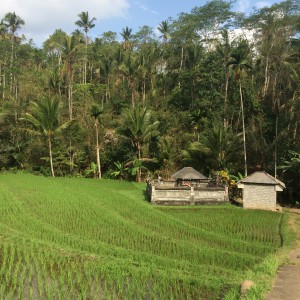
The path that you can sort of see on the right of this picture lead us to our bathing spot at the river. The structure near the path is a temple. Nothing like bathing with a view of the beautiful rice fields!
After the village we all traveled to North Bali for a few days, but this post is already quite long so I think I’ll do a “part two” post. I’m currently in the midst of my Independent Study Project (ISP), which will also be another post that I’ll write soon. I hope all is well in whatever part of the world you’re reading this! If you’re in Walla Walla (or other parts of the US), stay warm! It’s a bit hard for me to wrap my head around freezing temperatures as I sit here in my tank top and shorts, but it’s making me miss wearing sweaters and boots. Sampai nanti teman-teman! (see you later friends!).

